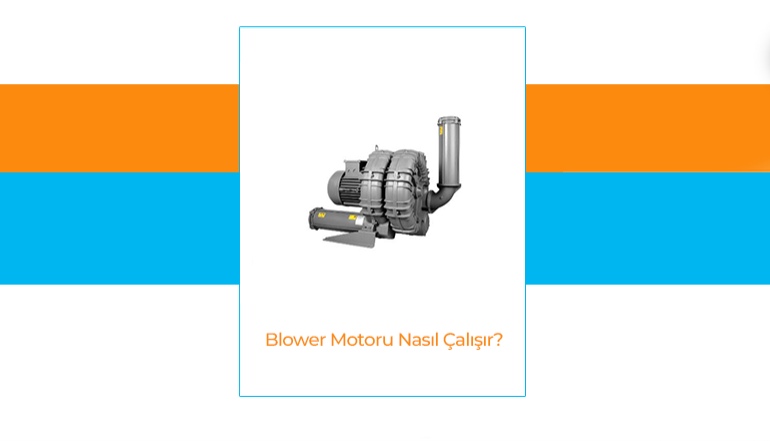- sisdoz@sisdoz.com.tr
- TR
Blog
- Home
- Sisdoz Blog
- How Does a Blower Motor Work?

Blower motors are one of the critical components used to provide air or gas flow. These motors, which are used in many areas from industrial facilities to the automotive sector, work based on mechanical and electrical principles. So, how do blower motors work? Which parts are involved in this process? In this article, we explain the working principles of blower motors in great detail.
1. What is a Blower Motor?
A blower motor is a motor used to direct air or gas flow and move it at the desired pressure. It is generally seen in ventilation systems, HVAC (Heating, Ventilation and Air Conditioning) systems and industrial applications.
✔ Blower motors optimize energy efficiency by increasing air flow.
✔ It can have different speed settings and can operate at low or high speed depending on the needs of the system.
2. Basic Components of Blower Motors
A blower motor consists of many interconnected components. Here are the parts of blower motors:
Electric motor: It is the main power source of the system.
Fan blades: It directs the air.
Bearings: It makes the rotational movement smooth.
Motor windings: It enables the motor to rotate by conducting electric current.
Capacitor: It starts the initial movement of the motor and ensures its stable operation.
The harmony of these components ensures that the blower motor operates efficiently and smoothly.
3. Working Principle of Blower Motor
The working principle of blower motors is quite simple. However, to understand how this system works, it is necessary to know the basic steps:
✅ Electric current passes through the motor windings: Electrical energy creates a magnetic field in the motor windings.
✅ Magnetic field enables the motor to rotate: The rotor starts to rotate under the influence of the magnetic field.
✅ Fan blades push the air: As the motor rotates, the fan blades also move and air flow is provided.
✅ Air is directed with a certain pressure: The direction and speed of the air can be adjusted according to the needs of the system.
✅ Heat distribution and ventilation are provided: The air is directed to the specified areas and the desired environmental conditions are achieved.
This process ensures that the blower motors work efficiently.
4. Differences Between AC and DC Blower Motors
Blower motors are divided into two types, AC (Alternating Current) and DC (Direct Current), depending on the power source:
AC blower motors: Widely used in home and industrial systems. Provides a stable power flow.
DC blower motors: Provides lower power consumption and is used in portable systems.
Both types of motors are suitable for different applications, but energy efficiency and area of use should be considered when making a selection.
5. Areas of Use of Blower Motors
Blower motors are actively used in many sectors:
📌 HVAC systems: Used in heating and cooling processes.
📌 Automotive sector: Used in in-car ventilation and air conditioning systems.
📌 Industrial facilities: Used to regulate air flow in factories.
📌 Vacuum cleaners: Blower motors are used to create strong air flow.
📌 Ovens and boilers: Provides air flow to support the combustion process.
These wide areas of use show how important a role blower motors play in our daily lives.
6. Advantages of Blower Motors
Blower motors have many advantages:
✔ Energy efficiency: Provides more air flow with less energy.
✔ Low maintenance: Has a long life thanks to its robust structure.
✔ High performance: Creates a strong air flow and quickly cools or heats the environment.
✔ Quiet operation: Modern motors can operate at low noise levels.
✔ Flexible use: Can operate at different speeds and pressure levels.
These advantages make blower motors ideal for various applications.
7. Problems and Solutions Encountered in Blower Motors
Blower motors may encounter some technical problems over time. Here are the most common problems and solutions:
⚠ Motor does not start: Check the fuse or power supply.
⚠ Poor air flow: Check if the fan blades are clean.
⚠ Motor overheats: Check if the bearings are lubricated and if the air inlets and outlets are open.
⚠ Noisy operation: Check if the motor bearings are worn. These simple precautions will help the blower motor last longer.
8. Blower Motor Maintenance and Ways to Extend Their Life
Blower motors require regular maintenance to ensure they last longer:
✔ Clean the fan blades: Clean regularly to prevent dirt and dust buildup.
✔ Check electrical connections: Check for loose cables.
✔ Lubricate bearings: Provide more efficient operation with less friction.
✔ Monitor motor temperature: Watch for signs of overheating.
These maintenance steps will help your blower motor run smoothly for longer.
9. Conclusion: Why Are Blower Motors Important?
Blower motors are one of the key components of ventilation, heating and cooling systems. They are used in many areas from industrial facilities to home systems, providing comfort and energy efficiency.
If you are considering purchasing or maintaining a blower motor, it is important to consider the information above. By making the right choice and performing regular maintenance, you can get maximum efficiency from your blower motor.

